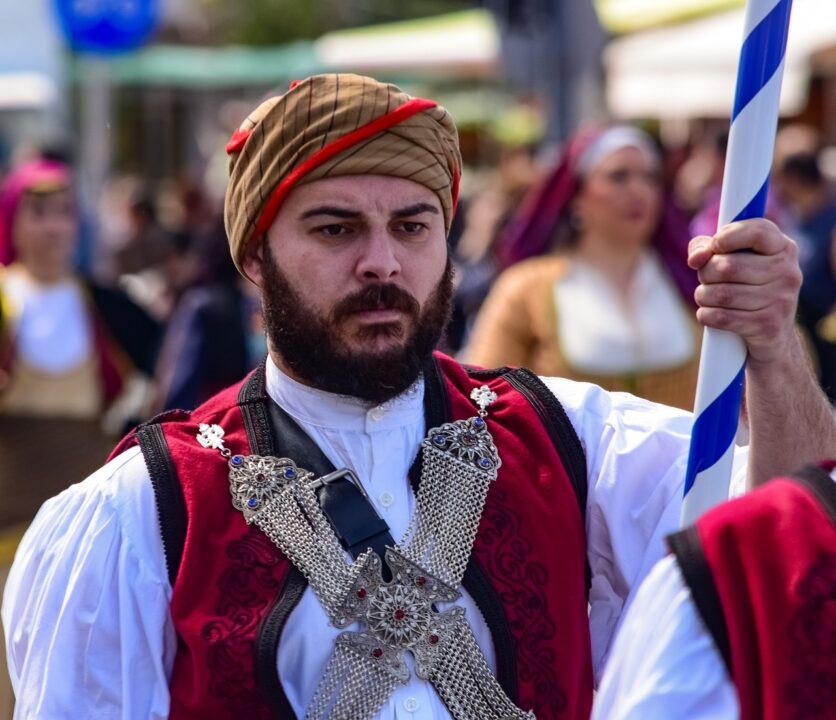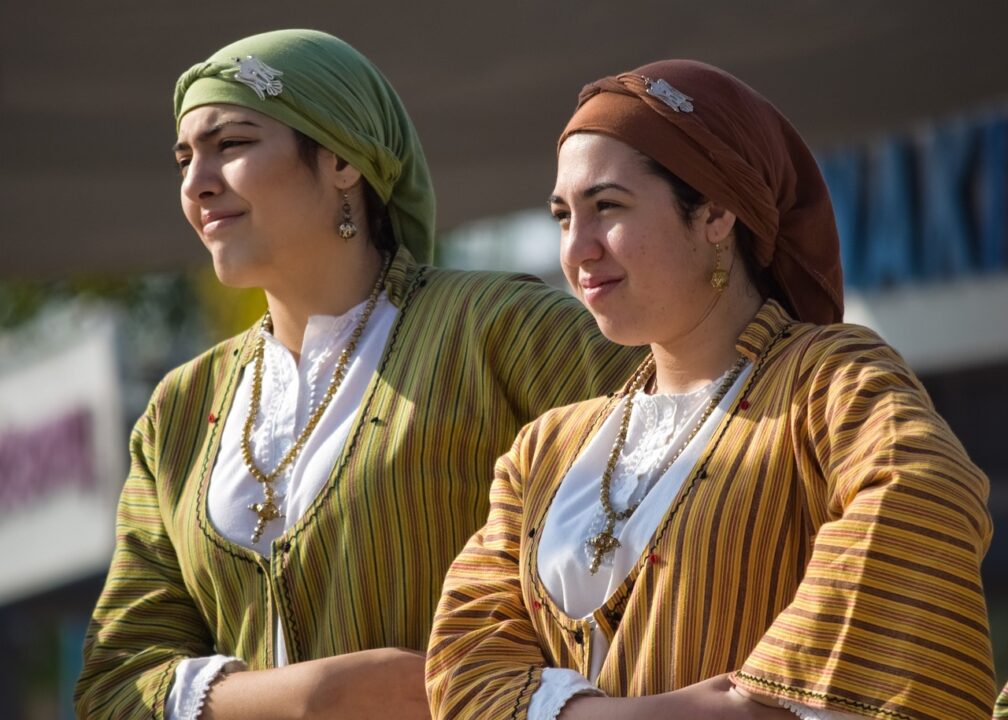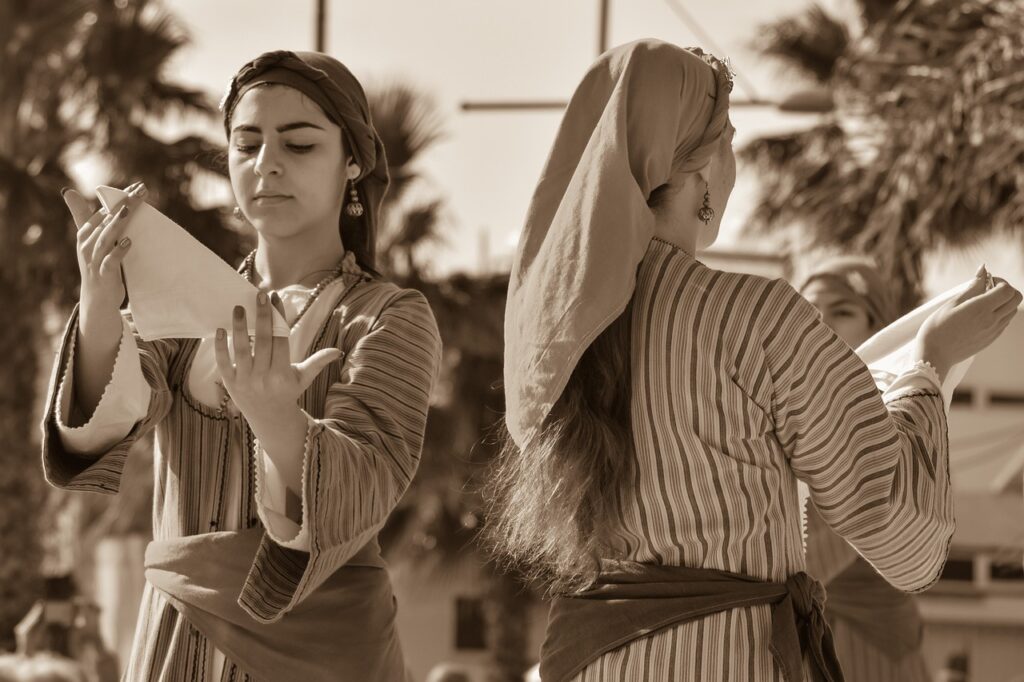Greece is an ancient country known for its enduring contributions to the excellence of history, art, philosophy, and fashion. As we delve into Greek traditional clothing, it’s imperative to take a look into the historical and cultural depths of Greece.
In this captivating journey through time, we will explore the intricate world of Greek traditional clothing, where history, art, and fashion seamlessly converge to create a magnificent tapestry of elegance.
Clothing during ancient Greece encompassed the period spanning from the Aegean Bronze Age around 3000 BCE to the Hellenistic era, concluding in 31 BCE.
The clothing of ancient Greece exhibited a wide array of styles, yet it primarily revolved around four key garments: the chiton, peplos, himation, and chlamys.
Greek traditional clothing, stretching across millennia, offers us a window into the intricate evolution of Greek culture and fashion.
In ancient Greece, clothing was not merely a matter of utility; it was a reflection of one’s societal status and values.
The ancient Greeks, known for their penchant for artistry and sophistication, adorned themselves with garments crafted from fine linen or wool, meticulously secured with ornamental clasps or pins.
Typically, the ancient Greek populace adorned themselves with a pair of garments draping elegantly over their bodies: an undergarment (known as the chitōn or péplos) and an outer covering (referred to as the himátion or chlamýs).
What individuals wore and when they wore it in ancient Greece were influenced by multifaceted factors, including politics, economics, society, and culture.
Types of Traditional Clothes in Greek

Greek clothing was characterized by its simplicity, loose-fitting, and gracefully flowing nature. In most cases, clothing was handcrafted from rectangular linen or wool fabric pieces, minimizing the need for intricate cutting or sewing.
These garments were typically fastened with decorative clasps or pins and often accompanied by a belt or girdle (known as the zōnē).
1. Chiton
A chiton, known as “khitōn” in Greek, is a type of tunic worn by both men and women in ancient Greece and Rome. It is fastened at the shoulder and comes in two variations: the doric and the later ionic.
According to Herodotus, a popular legend suggests that Athenian women adopted the chiton instead of the peplos because several women used the distinctive bronze pins of the peplos to fatally stab a messenger.
- Doric Chiton: This is a type of tunic made from a single rectangular piece of woolen or linen fabric. It can be worn plain or with an overfold called an apoptygma, which is more common among women. The doric chiton is draped and fastened at the shoulder using pins, sewing, or buttons.
- Ionic Chiton: The ionic chiton, also made from linen or wool, is draped without a fold. It is held in place from the neck to the wrist by several small pins or buttons.
- Zoster: A large belt called a zoster could be worn over the chiton, either high-girdled under the breast or low-girdled around the waist. The excess fabric of the chiton was pulled above the belt. There was also a double-girdled style. The chiton was often worn with the heavier himation over it, functioning as a cloak.
- Monochiton: When worn without a himation, the chiton was referred to as a monochiton. A long chiton that reached the heels was called a chiton poderes, while an even longer one that dragged on the ground was called a chiton syrtos or helkekhitōn. Women typically wore ankle-length chitons, while men wore knee-length ones, except for certain roles like priests and charioteers, who wore longer chitons.
2. Peplos
A peplos, known as in Greek, became the customary attire for women in ancient Greece around 500 BC, particularly during the late Archaic and Classical periods.
This garment was a lengthy, rectangular piece of fabric. The upper edge of the fabric was folded down approximately halfway, allowing the top portion of the rectangle to drape below the waist while the bottom part reached the ankles.
On one side of the peplos, there could be an opening, or it could be fastened together with pins or sewing. In a Roman context, it might be referred to as a palla.
3. Himation
The himation was a type of garment worn by both Greek men and women from the Archaic era to the Hellenistic period (approximately 750–30 BCE). It was an oversized rectangular piece of fabric that could be draped in various styles, such as a shawl, a cloak, or even used as a head covering, depending on the period.
Typically crafted from white wool, women sometimes wore versions made of colored silk or cotton. A similar but shorter Greek wrap was referred to as a chlamys.
3. Chlamys
The chlamys were constructed from a single piece of woolen fabric, usually bordered and roughly the size of a blanket. It was commonly fastened with a fibula at the right shoulder.
Originally, it was wrapped around the waist like a loincloth, but by the late 5th century BC, it was draped over the elbows.
While it could be worn over other clothing items, it often served as the primary garment for young soldiers and messengers, especially in Greek artistic representations.
Consequently, the chlamys are closely associated with Hermes (known as Roman Mercury), the messenger god often depicted as a youthful figure.
During the 5th to the 3rd centuries BC, the chlamys were the typical military attire for Greek soldiers. When worn by soldiers, it could also be wrapped around the arm and used as a lightweight shield in combat situations.
4. Fustanella
When discussing Greek traditional clothing, the fustanella invariably comes to the fore. This unique and instantly recognizable garment, traditionally worn by Greek men, holds a special place in Greek culture.
More than mere clothing, the fustanella symbolizes resilience and patriotism during turbulent chapters in Greek history.
5. Epiblema
The epiblema was a large cloak or mantle that was wrapped around the body. It is like a shawl, which could be worn by both men and women, draped over a chiton or peplos.
Certain women would embellish their attire with a shawl, which could range from a basic garment for added warmth to an ornate and decorative piece.
A finely crafted shawl, particularly if it featured vibrant dyes or intricate patterns, served as a conspicuous display of affluence. Men, too, would similarly accessorize their outfits.
Men and women dressed
In ancient Greece, men typically donned a chiton resembling the one worn by women, but it was often knee-length or even shorter. Attire for both women and men in ancient Greece encompassed two primary components: a tunic, which could be either a peplos or chiton and a cloak referred to as a himation.
The peplos, a piece of substantial fabric, often wool, was essentially a large rectangle. This fabric was folded over along the upper edge, forming an overfold called the apoptygma, which extended to the waist.
The peplos were people wrapped around the body and secured at the shoulders using a pin or brooch.
Armholes were left open on either side, and the unfixed side of the garment could either remain open or be pinned or sewn together to create a seam.
The waist of the people might be left uncinched without the use of a belt or girdle. On the other hand, the chiton was crafted from a significantly lighter material, typically linen imported from elsewhere.
It took the shape of an elongated and wide piece of fabric, with the sides stitched up, and it was fastened at the shoulders, often featuring a belt around the waist.
In many cases, the chiton’s width allowed for sleeves, which were affixed to the upper arms using pins or buttons. Both the peplos and chiton were floor-length garments that were usually long enough to be drawn over the belt, forming a pouch known as a kolpos.
Under either of these garments, a woman might choose to wear a soft band called a strophion, which encircles the midsection of the body.
Greek traditional clothing and activity synchrony

For activities such as exercise, horseback riding, or strenuous labor, they would opt for exotic races, which were short chitons secured at the left shoulder.
The himation, a cloak worn by both men and women, took the form of a rectangular piece of substantial fabric, typically made of either wool or linen.
It was draped diagonally over one shoulder or symmetrically across both shoulders, akin to a stole.
To enhance their attire, women occasionally added an epiblema, which was a shawl, over their peplos or chiton. Young men, particularly for riding, often favored a short cloak known as a chlamys.
On occasion, Greek men could be seen wearing a broad-brimmed hat referred to as a petasos, while Greek women, albeit rarely, sported a flat-brimmed hat featuring a high peaked crown.
Footwear for both genders encompassed sandals, slippers, soft shoes, or boots; however, when at home, it was customary to go barefoot.
However, women typically wore their robes trailing down to their ankles, while men, depending on the circumstances and the occasion, often opted for shorter lengths, reaching their knees.
Moreover, these garments served purposes beyond clothing, sometimes doubling as bedding or even shrouds.
A glance through the models of Greek men and women dressing
Men
To provide a visual glimpse into the world of Greek traditional clothing, let’s explore various attire worn by both men and women throughout different historical periods:
- Byzantine-era Working Class Man: Imagine a working-class man from Beroea sporting a distinctive red cap and light bracca (Vraka) trousers tucked into knee-high boots. This attire reflects the fashion of the Byzantine era.
- Otto of Greece in Fustanella: Otto of Greece proudly wears the fustanella as part of the Evzonas uniform, a tradition that endures to this day.
- Traditional Cretan Costume: This showcases the traditional clothing of the mountainous Cretans, featuring black trousers, shirts, stivania (Cretan boots), a black sariki (Cretan woven headscarf), and a gold neck chain.
Women
- Queen Hera: Queen Hera, wearing the national Greek costume, known as the Amalía dress. This attire reflects the Biedermeier style, characterized by a loose-fitting white cotton or silk shirt adorned with lace, along with a richly embroidered jacket or vest.
- Ioannina (19th Century): This model is a historical costume from Ioannina’s rich diversity of Greek traditional clothing with unique patterns and colors.
- Costume from Crete (Late 19th Century): The late 19th-century Cretan costume is a captivating blend of traditional and contemporary elements, featuring intricate patterns and a distinct headpiece.
- Princess Marie Phoebe: Princess Marie Phoebe exemplifies a member of the Greek royal family, wearing a traditional Greek costume complete with a fez and decorative tassel.
Colors and Symbols
Greek traditional clothing transcends the realm of fabric; it is a canvas onto which colors and symbols are meticulously woven, telling stories that span generations.
From the deep blues of the Aegean Sea to the striking reds and whites of the Greek flag, colors carry profound significance in Greek attire.
Furthermore, intricate patterns like the meander, an emblem of infinity and unity, are frequently integrated into the fabric’s design.
While Greek traditional clothing continues to occupy a cherished place in the hearts of the Greek people, it has also left an indelible mark on modern fashion.
Designers and fashion enthusiasts worldwide draw inspiration from these timeless garments, seamlessly incorporating elements such as pleats, drapery, and intricate embroidery into their collections.
Greek Traditional Clothing exhibited a rich and diverse array of colors, incorporating black, red, yellow, blue, green, and purple into their attire.
Yellow-dyed clothing was associated with various stages in a woman’s life cycle. Purple, in particular, was a hue favored by the elite, symbolizing wealth and affluence, primarily due to its status as the most costly dye, acquired through a challenging and resource-intensive process.
Furthermore, the ancient Greeks practiced the art of embroidery as a means of embellishing their garments. These embroidered designs encompass floral patterns, geometric motifs, and intricate depictions of scenes from Greek narratives.
An illustration of this embroidery can be found in Homer’s Iliad, where Helen is described wearing a purple textile adorned with an embroidered depiction of Trojans engaged in battle.
The revolutionary journey of Greek clothing
- The Byzantine period in Greek history ushered in notable changes in clothing, although it remained steeped in tradition. The Byzantines displayed a penchant for vibrant colors and intricate patterns, particularly in their highly sought-after silk fabrics. Borders and trims were common, often denoting social class or rank. The adoption of colors by political factions at the Hippodrome underscored the close connection between clothing and identity.
- Ottoman Period Clothing: Under Ottoman rule, Greeks fell under the category of the Rum Millet, with clothing regulations based on religious affiliation, social class, and occupation. These regulations occasionally resulted in chaos, particularly during the 17th century. Regional variations in clothing emerged, with islanders favoring the Vraka, a traditional type of breeches. The fustanella remained popular in rural areas and among the klephts and armatoloi. Urban elites, on the other hand, adopted Western European-style dress.
- The Modern Period: In the era of independent Greece, King Otto and Queen Amalia played pivotal roles in shaping the nation’s fashion landscape. Queen Amalia’s creation, the Amalía dress, stands as a testament to her influence. This romantic and folk-inspired court dress featured a loose-fitting, white cotton or silk shirt adorned with lace at the neck and cuffs. It was paired with a richly embroidered jacket or vest, often made from dark blue or claret velvet. The ankle-length silk skirt was typically azure in color. Completing the ensemble was a soft cap or fez with a single long, golden silk tassel, worn by married women, or the kalpaki, a toque, for unmarried women. Sometimes, a black veil was added for church visits. This dress became the standard attire for Christian townwomen in both Ottoman Empire-occupied and liberated Balkan lands, extending as far north as Belgrade.
Otto of Greece adopted the fustanella for his guard, a tradition that endures to this day with the Evzones, members of the Presidential Guard. Nevertheless, Greece’s fashion landscape has not remained static. It has evolved, embracing European standards, with completely black clothing being worn for a year in mourning.
Conclusion
Greek traditional clothing serves as a captivating tapestry of history, culture, and artistry. From the simple elegance of the chiton in antiquity to the enduring symbolism of the fustanella and the intricate embroidery of regional costumes, Greek attire reflects the nation’s rich and multifaceted heritage.
It is a testament to the resilience, creativity, and enduring spirit of the Greek people.
As the world of fashion continues to evolve, Greek traditional clothing remains a source of inspiration for designers and a symbol of cultural pride for Greeks worldwide.
Whether donned in celebration, performance, or daily life, these garments carry with them the echoes of centuries past, reminding us of the timeless beauty and significance of Greek fashion.
In closing, Greek traditional clothing is not merely fabric and thread; it is a living testament to a nation’s history and culture, an art form that has transcended time, and a source of inspiration for those who seek to connect with Greece’s rich and enduring legacy.



